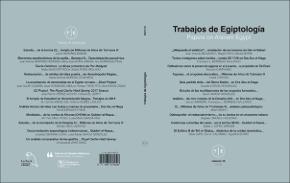Elementos arquitectónicos de la capilla funeraria de Sarenput II (QH31) en Qubbet el-Hawa. Caracterización geoquímica
Fecha
2019Resumen
La capilla del complejo funerario QH31 (Sarenput II), como el resto de hipogeos de la necrópolis de Qubbet el-Hawa, fue excavada directamente en la roca. Sin embargo, en la capilla existen algunos elementos destacados que, probablemente, fueron elaborados independientemente de los trabajos de excavación in situ, para ser situados en el lugar previsto como parte integrante del equipamiento funerario y el diseño general de la misma. Entre estos elementos destacan las tres parejas de estatuas osiríacas del corredor, los cuatro pilares de la cámara de las ofrendas y las losas con las que construyeron el santuario de la estatua del propietario de la tumba. Al encontrarse estos elementos revestidos para que sus superficies fueran aptas para ser decoradas, a simple vista es muy difícil determinar la piedra con la que fueron elaborados. Durante la última campaña (2018), el análisis in situ con técnicas no invasivas, como la Fluorescencia de rayos X, ha permitido determinar su composición química. Además, se han analizado algunos fragmentos de piedra, hallados durante las excavaciones que llevan a cabo desde el año 2008 el equipo del proyecto Qubbet el-Hawa (Universidad de Jaén), como son la peluca de la estatua decapitada de la pared norte del corredor y el fragmento de la jamba derecha de la fachada del santuario de la estatua. Los resultados de los análisis parecen indicar que estos elementos fueron elaborados con piedra arenisca muy similar a la de la propia excavación, y no con arenisca silicificada (cuarzoarenita) también muy abundante en Qubbet el-Hawa. Además, estos estudios muestran ciertas diferencias de composición entre la piedra utilizada para la construcción del santuario y otros elementos como las estatuas osiríacas. Finalmente, la losa del suelo del santuario, sobre la que se colocaba la estatua de Sarenput, es de piedra caliza de importación. The chapel of the QH31 funerary complex (Sarenput II) was excavated directly into the rock, like the rest of the hypogea of the necropolis of Qubbet el-Hawa. However, in the chapel there are some outstanding elements that, probably, were elaborated independently of the excavation works in situ, to be located in the planned place as an integral part of the burial equipment, and the general design of the chapel. These elements include, for example, the three pairs of Osiride statues in the corridor, the four pillars in the offering chamber, and the slabs with which they built the sanctuary of the statue of the grave’s owner.As these elements were found coated so as to make their surfaces suitable for decoration, it is very difficult to determine the stone with which they were made. During the last campaign (2018), in situ analysis with non-invasive techniques, such as X-ray Fluorescence, has allowed determining its chemical composition. In addition, some stone fragments found during the excavations carried out since 2008 by the Qubbet el-Hawa project (University of Jaén), have been analyzed, such as the wig of the decapitated statue on the north wall of the corridor, and the fragment belonging to the right jamb of the façade of the sanctuary housing the statue. The results of the analysis seem to indicate that these elements were made from a very similar sandstone to that of the excavation itself and not with silicified sandstone (quartzarenite), which was also very abundant at Qubbet el-Hawa. Besides, these studies show several differences in composition between the stone employed for the construction of the sanctuary, and other elements such as the Osiride statues. Finally, the slab on the floor of the sanctuary, on which the statue of Sarenput was placed, was made of imported limestone.





